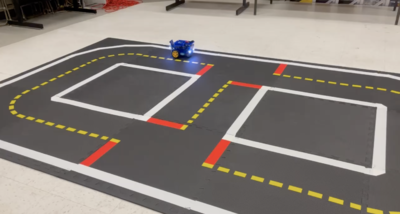SURF 2022: Evaluating Redundancy Between Test Executions for Autonomous Vehicles: Difference between revisions
No edit summary |
No edit summary |
||
| Line 7: | Line 7: | ||
==Project Description== | ==Project Description== | ||
For autonomy to be deployed in safety-critical settings, | |||
Testing autonomous systems requires defining the test environment, which comprises of test agents, obstacles, and test harnesses on the system under test. Test cases of varying complexity (length of the test, number of test agents and their strategies) could offer the same information on the system's ability to satisfy a requirement. Consider the following example of testing a miniature self-driving car on the Duckietown platform. The autonomous car to be tested has a controller that navigates indefinitely around a loop --- it needs to do lane following, avoid colliding with other cars and take unprotected left turns at intersections after reading appropriate road signs. The figure to the right shows a duckiebot on a simple layout; other duckiebots and mini road signs can be easily augmented to this setup. | Testing autonomous systems requires defining the test environment, which comprises of test agents, obstacles, and test harnesses on the system under test. Test cases of varying complexity (length of the test, number of test agents and their strategies) could offer the same information on the system's ability to satisfy a requirement. Consider the following example of testing a miniature self-driving car on the Duckietown platform. The autonomous car to be tested has a controller that navigates indefinitely around a loop --- it needs to do lane following, avoid colliding with other cars and take unprotected left turns at intersections after reading appropriate road signs. The figure to the right shows a duckiebot on a simple layout; other duckiebots and mini road signs can be easily augmented to this setup. The duckiebot under test has an off-the-shelf controller implemented on-board for indefinite navigation around the track. In addition to the hardware setup, we have access to a simulator of the hardware setup that could potentially be useful in designing our experiments. | ||
[[Image:Screen Shot 2021-12-20 at 11.27.21 PM.png|right|400px]] | [[Image:Screen Shot 2021-12-20 at 11.27.21 PM.png|right|400px]] | ||
For example, tests can generally be classified into four different categories --- open-loop test in a static environment, open-loop test in a dynamic environment, reactive test in a static environment, and a closed-loop test in a reactive environment. | |||
For this SURF, we would like to implement a few tests in test environments of varying complexity on the Duckietown hardware. We would then like to characterize the test scenarios for when two tests are redundant and when they are not. We can show this by defining and computing a notion of information gain over the test and show that a more complex test may or may not offer any new insight regarding system performance. | |||
==Requisites== | |||
* Experience coding in Python | |||
* Willing to learn development on Docker and Github | |||
* Interest in hands-on robotics experience | |||
==What you can possibly expect from this SURF== | |||
* Get a sense of the research frontier on test case generation for autonomy | |||
* Hands-on experience with | |||
==References== | ==References== | ||
1. Duckietown. https://docs.duckietown.org/daffy/duckietown-robotics-development/out/index.html | |||
Revision as of 05:49, 21 December 2021
2022 SURF: Evaluating Redundancy between Test Cases
- Mentor: Richard Murray
- Co-mentors: Apurva Badithela, Josefine Graebener
Project Description
For autonomy to be deployed in safety-critical settings,
Testing autonomous systems requires defining the test environment, which comprises of test agents, obstacles, and test harnesses on the system under test. Test cases of varying complexity (length of the test, number of test agents and their strategies) could offer the same information on the system's ability to satisfy a requirement. Consider the following example of testing a miniature self-driving car on the Duckietown platform. The autonomous car to be tested has a controller that navigates indefinitely around a loop --- it needs to do lane following, avoid colliding with other cars and take unprotected left turns at intersections after reading appropriate road signs. The figure to the right shows a duckiebot on a simple layout; other duckiebots and mini road signs can be easily augmented to this setup. The duckiebot under test has an off-the-shelf controller implemented on-board for indefinite navigation around the track. In addition to the hardware setup, we have access to a simulator of the hardware setup that could potentially be useful in designing our experiments.
For example, tests can generally be classified into four different categories --- open-loop test in a static environment, open-loop test in a dynamic environment, reactive test in a static environment, and a closed-loop test in a reactive environment.
For this SURF, we would like to implement a few tests in test environments of varying complexity on the Duckietown hardware. We would then like to characterize the test scenarios for when two tests are redundant and when they are not. We can show this by defining and computing a notion of information gain over the test and show that a more complex test may or may not offer any new insight regarding system performance.
Requisites
- Experience coding in Python
- Willing to learn development on Docker and Github
- Interest in hands-on robotics experience
What you can possibly expect from this SURF
- Get a sense of the research frontier on test case generation for autonomy
- Hands-on experience with
References
1. Duckietown. https://docs.duckietown.org/daffy/duckietown-robotics-development/out/index.html
